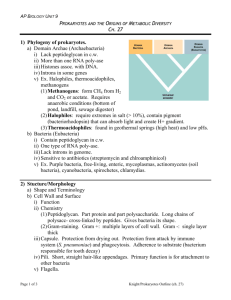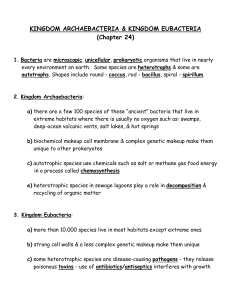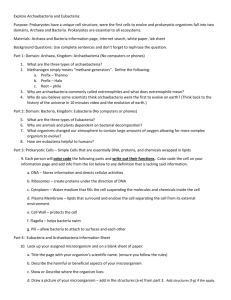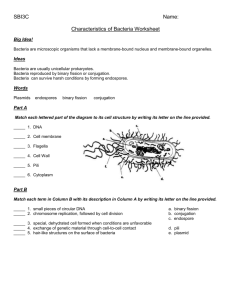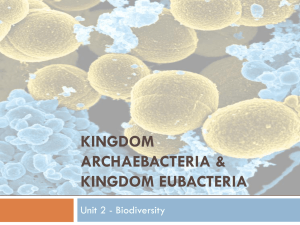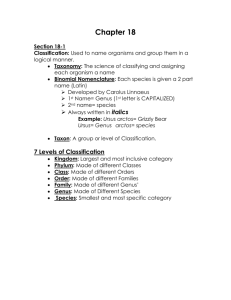Bacteria Classification
advertisement
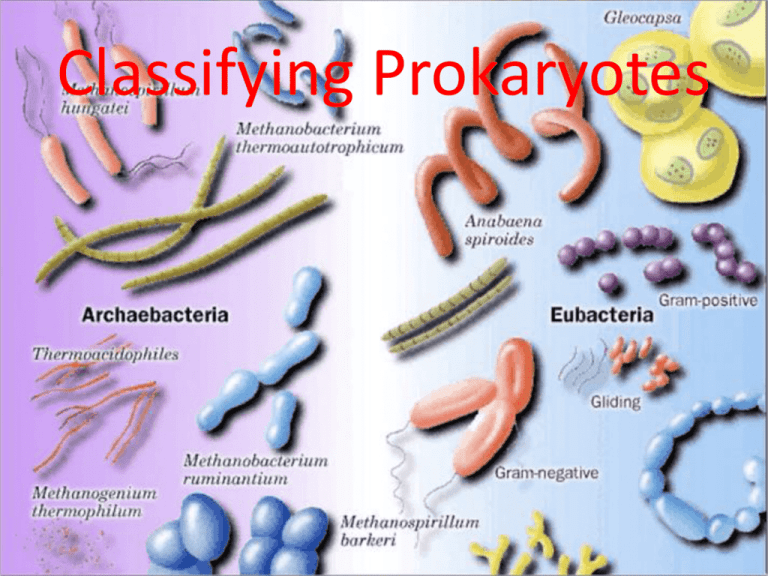
Classifying Prokaryotes
• Prokaryotes are microscopic
with no nucleus
• They are the most ancient (oldest) and most
numerous organisms on the planet.
There are 2 Kingdoms:
ARCHAEBACTERIA
EUBACTERIA
Kingdom Archaebacteria
•
•
“Archae” means “ancient” bacteria
They are “extremists”
1. Methanogens: live in oxygen-free environments
anaerobic conditions
convert H2 & CO2 into methane gas
2. Thermoacidophiles: live in water that is extremely HOT
(230º F) and ACIDIC (pH < 2).
3. Halophiles: live in extremely SALTY conditions
HALOPHILES
THERMOACIDOPHILES
METHANOGENS
THERMOACIDOPHILES
METHANOGENS
Archaebacteria
• Many live in extremely harsh
environments
• Methanogens live in oxygen-free
environments
• Others in extremely salty environments
(Great Salt Lake) Halophile
• Hot springs where temperatures
approach the boiling point of water
“ExTrEmE!”
salt ponds
• halophiles (e.g., salt flats)
• methanogens (e.g., anaerobic)
• thermophiles (e.g., hydrothermal vents)
Thermus aquaticus
hot springs
•Extremophiles, “lovers” of extreme environments.
Kingdom Eubacteria
•
•
“TRUE” bacteria – (most bacteria)
Classified according to how they obtain energy
1. Heterotrophs: Energy from organic matter
• Parasitic: energy from living organisms
• Saprobes: feed on dead organisms
2. Phototrophic Autotrophs
• Energy from light
3. Chemotrophic Autotrophs
• Energy from breakdown of inorganic
compounds
Eubacteria
• The larger of the two classifications.
• Live almost everywhere: Fresh water, salt
water, on land and on and within the
human body.
Characteristics/Comparison
Bacteria & Archaea
Unicellular
Prokaryotes (no membrane-bound nucleus)
Smaller than Eukaryotic cells
Domain Bacteria
Peptidoglycan cell walls
Plasma membrane similar to Eukarya
Unique ribosomes
Domain Archaea
Polysaccharide cell walls
Unique plasma membrane
Ribosomes similar to Eukarya
Bacteria Classification
Structure of Bacteria
• Bacteria are classified by 2
characteristics:
–Arrangement
–Shape
Cell Wall
• Determines shape.
Some have a second
membrane outside
the cell membrane
that makes them
especially resistant
to damage.
SHAPE
Shapes
– bacillus- rod shaped
– coccus- circular
• in chains called streptococci
• in clusters called staphylococci
– spirillum- spiral-shaped
Arrangements
• Paired: diplo
• Grape-like clusters: staphylo
• Chains: strepto
Examples
• Streptococcus:
Chains of spheres
• Staphylospirillum:
Grapelike clusters of spirals
• Streptobacillus:
Chains of rods
Bacteria Cell Structure
• cell wall: peptidoglycan
• chromosome: single; circular
•pili: hair-like structures
* conjugation
* cell-to-cell contact
• flagella: whip-like structure
* locomotion
• capsule: sticky “coat”
* extra protection
Flagella
• Motility - movement
Endospores
• Structure in some bacteria that is resistant
to adverse environmental factors.
• Boiling >1 hr still viable
Gram Stain
• Gram Positive- turn purple
from gram stain
• Gram-Negative- Do not
take on purple and turn
pink (Resistant to Antibiotics)
Eubacteria: Chemotrophic
Autotrophs
• Get energy by breaking down
inorganic substances like sulfur
and nitrogen
• Make nitrogen in the air usable
for plants {Very Important}
Lactic Acid Fermentation
• Fementative bacteria that produce lactic acid
under anaerobic conditions. Release energy by
producing ATP in the absence of oxygen.
• Dairy industry
– cheese, cottage cheese, yogurt
Alcoholic Fermentation
• Produces carbon dioxide as well as alcohol.
-- causes bread dough to rise.
26
